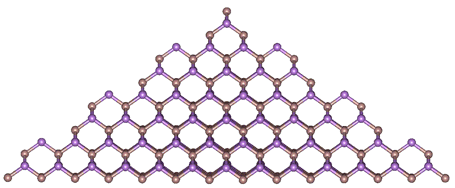Self-Assembled Quantum Dot Structure (pyramid)
Licensed under Creative Commons BY-NC-SA 3.0.
Category
Published on
Abstract
A pyramidal InAs Quantum dot that is 27 atomic monolayers wide at the base and 15 atomic monolayers tall. This corresponds to 6.5 cubic unit cells width and 3.5 cubic unit cells height, which in turns corresponds to about 3.9 width and 2.1nm height. Typically these quantum dots are about 20nm wide and 5nm tall and encapsulated by GaAs. This small dot provides insight into the crystal symmetry of z zincblende crystal viewed from different angles and a pyramidal quantum dot.

The semiconductor InAs can be grown as a crystal on top of a GaAs substrate. Since the natural InAs lattice constant is larger than the one of GaAs the material can clump up to form nanoscale, perfect crystal structures that can take on pyramidal or dome shapes. Typical sizes of such quantum dots are 20nm in diameter and 5nm in height. The InAs material is typically capped / overgrown with GaAs. The central structure can confine additional electrons and form an artificial atom. Such artificial atoms can have optical properties like natural atoms like the ability to absorb and emit light. The frequency or wavelength of this optical activity can be designed by quantum dot size, shape and material composition.
The atomistic structure was computed with the Nanoelectronic Modeling Tool (NEMO 3D).
Credits
Purdue University
References
- Quantum Dot Design:
Muhammad Usman, Hoon Ryu, Insoo Woo, David S. Ebert, and Gerhard Klimeck, "Moving towards nano-TCAD through multi-million atom quantum dot simulations matching experimental data", IEEE Transactions on Nanotechnology, Vol. 8, Issue 3, pg. 330-344 (2009), DOI: 10.1109/TNANO.2008.2011900 (2009). (available Purdue e-Pubs) - NEMO-3D
Gerhard Klimeck, Shaikh Ahmed, Hansang Bae, Neerav Kharche, Steve Clark, Benjamin Haley, Sunhee Lee, Maxim Naumov, Hoon Ryu, Faisal Saied, Marta Prada, Marek Korkusinski, and Timothy B. Boykin, "Atomistic Simulation of Realistically Sized Nanodevices Using NEMO 3-D: Part I - Models and Benchmarks", Special Issue on Nanoelectronic Device Modeling in IEEE Transactions on Electron Devices, Vol. 54, Issue 9, pg. 2079 - 2089 (2007). (available on nanoHUB.org) - nanoHUB.org:
Alejandro Strachan, Gerhard Klimeck, Mark S. Lundstrom, "Cyber-Enabled Simulations in Nanoscale Science and Engineering", Computing in Science and Engineering, Vol. 12, pg: 12-17 (2010). (available on nanoHUB.org)
Cite this work
Researchers should cite this work as follows: